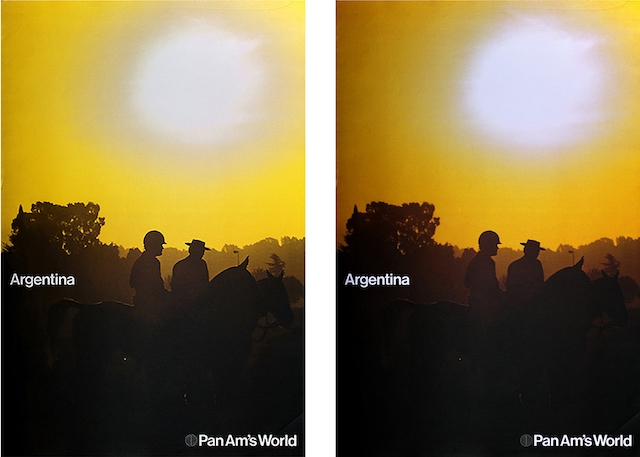Image caption: Pan Am Argentina | Housed in Ingleside, Illinois – 16.05.2012 (left), Pan Am Argentina | Housed in Detroit, Michigan – 12.03.2010 (right), part of the community of 12 occurrences of appearance bound by a search on the internet in between 27 and 29 November 2019, c-prints, 175 × 117 cm (each). © design by Chermayeff and Geismar, 1971. © photography by Elliott Erwitt / Magnum Photos. Courtesy the artist and Ingleby Gallery, Edinburgh
The three buildings occupied by Ingleby Gallery over the past 22 years have always presented a challenge to critics. The immaculate and elegant interiors are so distractingly beautiful that it can be hard to see artworks at all. Ingleby’s new home was designed and built as the Meeting House of the Glasites, an austere eighteenth-century Scottish sect whose beliefs included the view that beauty and art were inherently corrupt – followers of the Reverend John Glas were forbidden to indulge in superfluous decoration or art of any kind. It is ironic that their place of worship is now a gallery, though the building’s iconoclastic history makes it a fitting site for new works by Marine Hugonnier, an anthropologist and philosopher turned artist, whose career has centred on the politics of representation and image-making.
Hugonnier is primarily known as a filmmaker for works such as the trilogy Ariana (2003), The Last Tour (2004) and Travelling Amazonia (2006), and her Travel Posters continue The Last Tour’s examination of the tourist gaze through a series of large-format images of Ivan Chermayeff and Tom Geismar’s iconic 1971–72 Pan Am advertising campaigns. Using existing Magnum photographs, the designers created exotic, evocative jet-age posters of travel destinations. They suggest rather than depict the countries they represent: there are no identifiable landmarks or travel advertising tropes such as traditional dress, exotic animals or local cuisine. The works evoke the romance of travel itself, eliciting desire and dreams of escape, and rather than acting as an illustration of the country name (spelled out in Helvetica at the top or bottom of each poster), the hazy, distant images of sunsets, seas and lush foliage are contemplative, allowing the viewer a level of associative agency unusual in design of the period.
In re-presenting these works as her own, the exhibition might appear as latter-day appropriation art – the Argentina works in particular seem to invite this comparison: ochre-hued cowboys against a huge setting sun. Yet Hugonnier reroutes these assumptions. Alongside the originals (provided by the designers themselves) are similar, but not identical iterations. Hugonnier presents the works as c-prints encased in custom-made Perspex box frames: three of Hawaii, three of South America and five of Argentina. Hugonnier has stalked the images’ passage from object to data, charting the ‘journey’ of the posters over decades by finding and comparing apparently identical versions of the posters online. Close analysis of changes in the data of the images allowed her to trace where and when specific works had been uploaded – the resulting differences in hue, tone and resolution across various iterations are revealed when the works are hung together. In the case of Hawaii, the additional pixilation almost enhances the meditative effect of surfers immersed in a shimmering sea. Titles become itineraries of the works’ journey: Pan Am Hawaii / Housed in Palo Alto, California – 06.09.2015 (2019), for example, was one of 12 found in a restricted two-day internet search.
But though Hugonnier’s intervention and ‘compare and contrast’ detective work facilitates and increases our appreciation of the works and their travels, it is Chermaye. and Geismar’s singular, nostalgic designs that ultimately hold our attention. As John Glas cautioned, images have the power to undermine ideas. Beauty can lead us astray. In a windowless room, lit by a large cupola, the shimmering posters transport us to places far beyond Edinburgh and the head-turning space of the gallery.
Marine Hugonnier: Travel Posters, Ingleby Gallery, Edinburgh, 1 February – 28 March 2020
From the March 2020 issue of ArtReview
